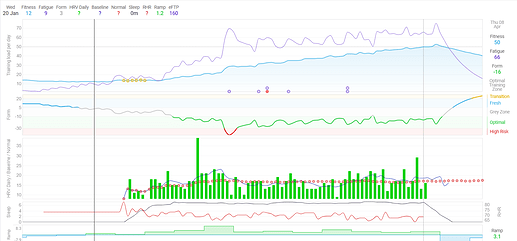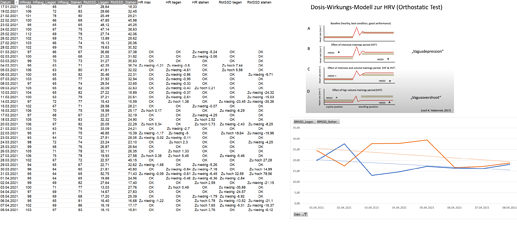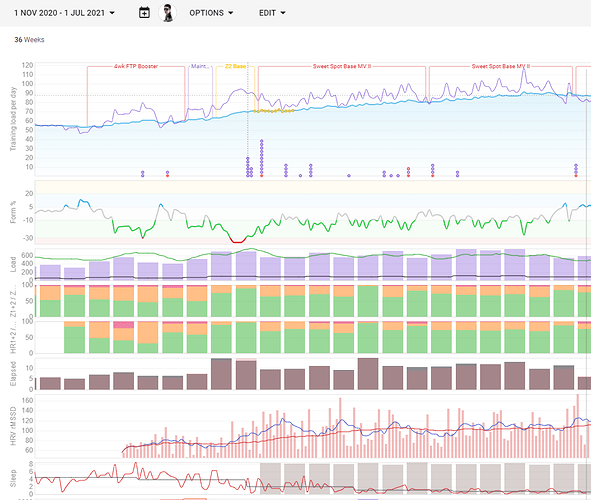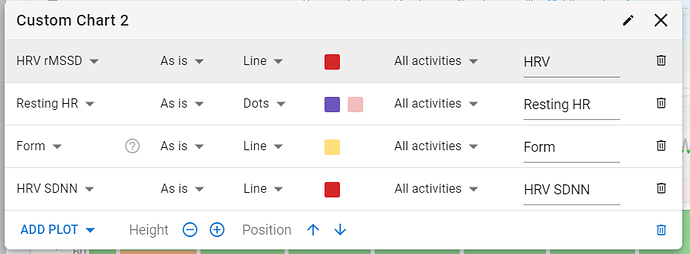I measure HRV with Edge 130, but i think my Polar is an H11?
I’m using Edge 830 with Garmin Dual HRM. This week I connected the Garmin chest strap to the Edge by Bluetooth because apparently, the HR signal over Bluetooth is more reliable then ANT+ when it comes to recording R-R intervals. Read that on one of the blogs about dfa-a1:
https://the5krunner.com/2021/02/25/important-training-news-dfa-alpha-1-new-threshold-discovery-method-with-hrv/
Already tried a slow ramp test (6min steps of 4% FTP from 55-91%) for estimating VT1 that way but the result is rather uncertain, although the number of artifacts seems low. Tried post-ride calculation with Google Colaboratory link higher up this thread. It returns a VT1 HR of 131 which might be correct but the graph isn’t showing me a nice decline in dfa-a1 so I’m sceptical. I will try again later this week and crosscheck the results.
Anyway, this is all very new and needs more refining. The good thing is, that it is open to everyone.
I have read that this should be done with a ramp rate below 10W/min, but ideally 5W/min. Somewhere in this very informative blog post:
What did 4% every 6mins give you in terms of absolute ramp rate?
For my part, I have tried a 5W/min and 10W/min ramp rate. The 5W/min ramp gave me reasonable results - with 0.7 correlation coefficient between DFA-alpha1 and HR (data filtered for artefacts) during the ramp portion of my activity. The 10W/min ramp gave me junk though! Effectively no correlation at all (0.2 correlation coefficient).
I think I will try that 5W/min ramp again next time I test to see how my results compare. But to be honest 0.7 correlation is still quite weak so I will also consider different protocols to the ramp test that I’ve been doing - from 100W to failure which takes a long time!
I’ve deployed HRV for myself with a medical-grade ECG , and curiously monitoring and studying signals over last 4 years. So this tugs at my interest.
One thing I can tell you is that spot checks everyday may not be nearly as instructive as “trends” over longer time spans. Spot checks will have you being very reactive to what the app is showing you. Sometimes that can be disruptive to a plan you have already made. Not every dip in HRV demands an immediate reaction from the owner of the heart 
A longer term downward trend over 3-4 days outside of normal variability bounds, OTOH, might be indicative that something negative is happening, an impending illness for example…OR an NFOR scenario.
Secondly, the paper is proposing this scheme for professional athletes. This segment of the population often have low resting heart rates to begin with. Despite training and adapting well, the bradycardia leads to a phenomenon called saturation, which can also bring down HRV. I wonder how the authors propose dealing with this.
H10 strap is the most accurate for measuring HRV of any strap. On HRV4Training app they bluetooth to the H10 for “device” based measurements instead of camera based measurement!
I’ve setup this on the Fitness page:
Inspired on Marco Altini’s way of monitoring rest HRV.
The green bars are daily RMSSD. The dark blue line is a 7 day rolling average of RMSSD and gives you short term trend. The red dots are 42 day average for a long term trend. That last one should actualy be 60 day rolling average with tolerance of 75% of the Standard Deviation but that’s not possible in intervals right now. This tolerance band is considered your “normal values”.
Combined with training load, sleep quantity/quality and other influencers, this chart can give you some insight.
4% turns out about 8W for me. So I guess 8W steps every 6 min should be good as protocol. But it could just be my Garmin Dual chest strap that isn’t good enough for this kind of testing. Hard to say. Not enough details for now, I will test again and see if anything turns up.
This is how it looks like in excell:
Yellow bars: daily RMSSD
Blue Line: 7day rolling avg RMSSD
Light Blue band: 60day rolling average +/- 0.75 SD
Is there a good resource for comparing the relative strengths of different HR straps for HRV measurement? (Or, how is it known that the Polar H10 is “the most accurate”?)
Polar H10 is actually the only one “validated”. There are probably other ones just as good but no comparison and/or exhaustive testing has been done. There are only a couple guys doing all this work on dfa-a1 for now. Bruce & Marco being the most implicated. @Coach_Ron uses a medical grade ECG which is the Gold standard.
Edit: There is some discussion about differences in HRM at 10:15 in this Podcast
https://x3training.com/endurance-innovation-97-bruce-rogers-with-updates-to-dfa-a1-analysis-and-garmin-metrics/
I am also playing around with HRV, but using the orthostatic test (like Polar is using it). Measurements with Polar H10 and Android App “HR Monitor” → .txt to One Drive → automatic Excel import.
The process is 2min lying, stand up, 2min standing.
Baseline 42days, window is baseline ±SD.
Sorry in German (it’s about too low or too high and the percentage as number):
Analysis is based on HRV Modell by Prof. Hottenrott. Unfortunatly I haven’t implemented no nice looking graphs yet.
My plan is a weekly CSV download of intervals to see correlations of intensity, HRV, Sleep Quality, …
BR
Stefan
Thanks for sharing @MedTechCD - I was using a different graph but your one seems a better way to track.
Some initial observations (not rocket science but nice to observe nonetheless):
- Daily HRV variance has reduced over the last 6 week period which coincides with me stopping drinking alcohol
- HRV trends downwards throughout the week (and training block) as I get more fatigued
- HRV has trended upwards as I have got fitter across the season
Not sure if you considered log transforming rMSSD for your Excel plots. I log transform the spectral domain variables too. This appears to be superior, even for elite athletes, to account for HRV saturation. It might also decrease some of the effects of breathing frequency upon raw rMSSD values.
Your method is quite good, you’re monitoring the “adaptability” of the body in orthostatic challenge. Supine only measurements may only show one side of the coin.
Orthostatic HRV measurements is what I implement in my monitoring. But I consider 2 minutes as bit short. I go for 5 minutes minimum time window.
Imagine now if you could combine this with a couple of countermovement jumps done first thing in the morning. I never tried it but I know Polar V800 has that in its test mode. To combine these values all together in monitoring would be useful and interesting.
I just added that. You are doing some really neat stuff here. When this thread settles down I will add a “Resting HRV” preset chart like yours.
I’m honoured by the compliment 
But I wouldn’t be able to do this without a host. A host that puts up an app that makes every commercial alternative look like a joke. A host that is truly open-minded and very responsive. I’m taking a deep bow for all the work you’re putting in. I’m feeling like a fish in the water on this forum and all that, helps me a lot to be consistent in training.
@david When coding a preset HRV chart, it’s probably best to keep the fraction of the SD configurable (or not too “hardcoded”) because I found multiple values. The most recent value used is 0.75 but there seems to be some debate.
@Coach_Ron regarding log transformation: I will have to read up on that because I don’t like doing things that I don’t understand. I’ll have to educate myself a bit first. Looks like it does not much more then scaling the results to a handy range. Recovery points from HRV4Training and Readiness from Kubios are a scaled log transformed number from RMSSD.






 60days rolling avg available
60days rolling avg available